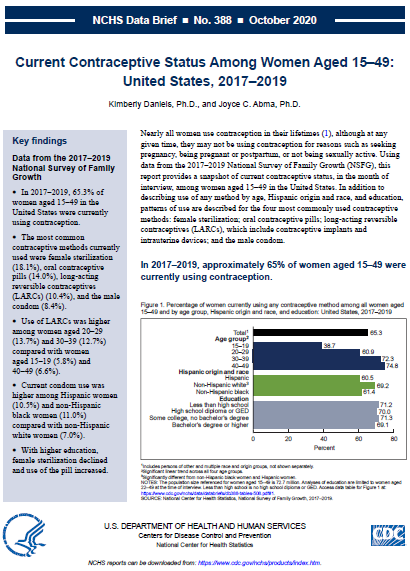Current Contraceptive Status Among Women Aged 15–49: United States, 2017–2019
Posted on by Questions for Kim Daniels, Health Statistician and Lead Author of “Current Contraceptive Status Among Women Aged 15–49: United States, 2017–2019.”
Questions for Kim Daniels, Health Statistician and Lead Author of “Current Contraceptive Status Among Women Aged 15–49: United States, 2017–2019.”
Q: Why does the CDC collect information on contraceptive use?
KD: Collecting information on contraceptive use from women and men of reproductive age helps inform our understanding of variation in use across groups such as by age and education. Information on contraceptive use offers potential insight into larger fertility patterns, including birth rates and incidence of unintended pregnancies. The chance that a woman not seeking a pregnancy will have an unintended pregnancy varies by whether any method of contraception is used and which method or methods she and her partner use.
Q: Was there a specific finding in the data that surprised you from this report?
KD: This report provides a snapshot of current contraceptive status among women ages 15-49 based on data from the 2017-2019 National Survey of Family Growth (NSFG). It describes contraceptive use and non-use during the month of interview and includes further detail on specific methods being used and reasons for non-use of contraception. Differences in the most common methods currently used (female sterilization, oral contraceptive pill, long-acting reversible contraceptives (LARCs), and the male condom) are shown by age, Hispanic origin and race, and education.
It may not count as surprising, but some of the overall percentages for specific types of methods being used are interesting. If you look at contraceptive status among all women (shown in Figure 2), 18.1% of all women aged 15-49 are relying on female sterilization, 14.0% on the oral contraceptive pill, 10.4% on LARCs, and 8.4% on male condoms. Taken together that accounts for about half of women in this age range (about 37 million of the 72.7 million women aged 15-49).
Some of the differences in current contraceptive use, by age, Hispanic origin and race, and education may be surprising. For example, there are differences by education in the use of female sterilization, the oral contraceptive pill, and LARCs, but there are no statistically significant differences seen by education in the use of male condoms, as reported by women.
Q: How did you obtain this data for this report?
KD: This report is based on data from the 6,141 women in the female respondent file of the 2017-2019 National Survey of Family Growth (NSFG). The NSFG is a nationally representative sample of women and men ages 15-49 conducted using in-person interviews. The 2017-2019 NSFG public-use data files are being released on the same day as this report. Information about the survey, including how data were collected, as well as the downloadable data files and documentation, are available on the NSFG website here: https://www.cdc.gov/nchs/nsfg/index.htm
Q: Is there any trend data for this report?
KD: This report does not include any information about trends in contraceptive use. However, since it is an update of a report published in 2018 using NSFG data from 2015-2017, comparisons can be made between the estimates in this report and those from the 2018 report. The 2018 report using 2015-2017 NSFG data is available on the NCHS webpage here: https://www.cdc.gov/nchs/data/databriefs/db327-h.pdf
Q: Where can I find more NSFG data?
KD: All NSFG data files, including the 2017-2019 public-use files, released on the same day as this report’s publication, are available to download from the NSFG website here:
https://www.cdc.gov/nchs/nsfg/index.htm
The NSFG website also includes information about the survey, including how data were collected, as well as documentation about the survey methodology and how to analyze the data. Also on our website are reports published from data files released prior to this, which show statistics for contraceptive use and many other topics included in the NSFG.
Those previously published NSFG reports are available on this page:
https://www.cdc.gov/nchs/nsfg/nsfg_products.htm
This report is the first to be released with this data from 2017-2019.
Posted on by

